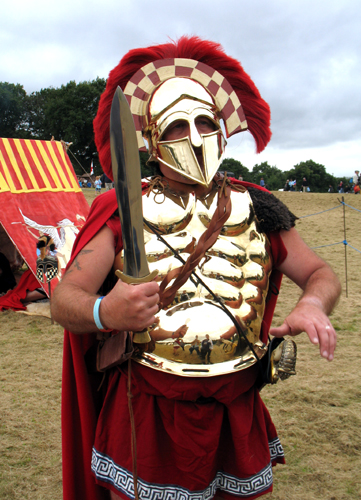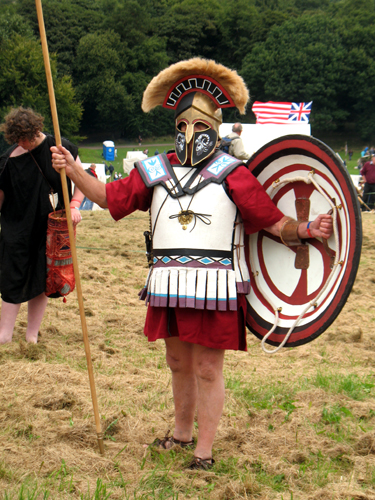The Shield
A hoplite's main form of protection was his shield (in Greek, aspis - not hoplon as is sometimes thought). These were round, so that nothing could catch on them in the tight formations of battle (called the phalanx). As we can see from the carving to the right, shields were big enough to cover a hoplite from chin to thigh. The size ranged from 80-100cm.
Shields gave a hoplite good protection, but the idea was that they helped protect the man to his left. A hoplite would himself be partly protected by the shield of the man to his own right. In the phalanx the shields overlapped slightly, and so a sort of wall of shields was formed (see picture below right). This was one of the main reasons the phalanx was so strong.

The Bowl Shape
Shields were also bowl-shaped. There was a rim, and inside this the shield bulged out. We can see this in the photo below of a bronze statue where the shield is seen from the side. This made the shield much harder to make. However it was very useful. Can you guess why?
Shields weighed about 7kg (15lbs) and could get heavy if carried for a long time. The bowl shape was perfect for resting the shield on the shoulder. We see this in the vase painting below right.

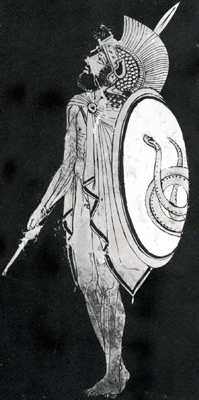

What was a shield made from?
Shields were mainly made of wood. Inside, handles were fitted and nailed into place. You can see the shape of the handles in the carving at the top of this page and in the picture below. The forearm went through a bronze band called the porpax, and the hand grasped a rope near the rim, called the antilabe.

The nails were flattened on the outside, then the front of the shield was covered with a layer of bronze, beaten into shape and wrapped round the rim. Sometimes ox hide was used instead of bronze. The inside was also lined with leather.
Shield Designs
Hoplites painted a huge variety of pictures on their shields. Some examples are shown right (see also the re-enactors' shields above). The pictures range from simple patterns like diamonds, to letters, to animals and plants, to objects like anchors and tripods. Why did they do this?
1. Sometimes the design stood for the hoplite's clan (his extended family).
2. Sometimes the letters stood for a city - for example A for Athens, or Λ (Greek letter lambda, or L) for Lakedaimon (meaning Sparta).
3. Often the design stood for a quality the hoplite wished to have. A bull, ram or lion stood for strength and might, a snake for striking power and speed, a scorpion for deadliness, a hare for speed, an anchor for steadfastness, a fighting cock for courage, and so on.
4. The designs also allowed hoplites to identify each other. In the thick of battle, when everyone was wearing helmets over their faces, it was hard to tell who was who!



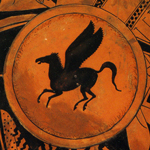
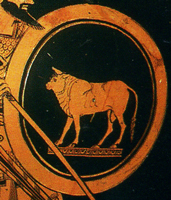
A hoplite was also protected by a helmet, usually made of bronze. There are many kinds. Most had a crest on top - a row of horsehair meant to look like a horse's mane, to help scare the enemy. The helmets we have in museums lost these crests long ago.
The pictures to the right show two examples of one of the most popular kinds of helmet - the Corinthian. The re-enactors above are all wearing Corinthian helmets.
These helmets gave very good protection but reduced vision and hearing quite a lot. They must have also made the wearer pretty hot! Later on a hole was cut for the ears so hoplites could hear better. A cloth cap was also worn inside the helmet to soften blows to the head.
Crests were often brightly coloured and patterned - see the vase painting below.
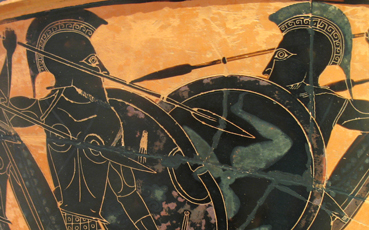
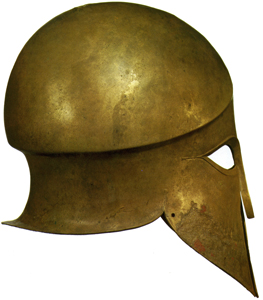
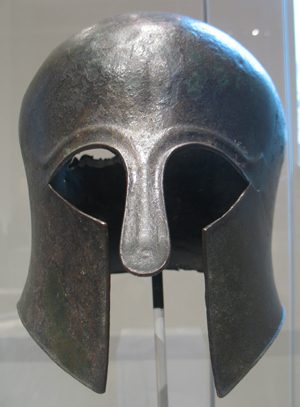
Another common type of helmet was the Thracian - this had hinged cheek flaps. Examples can be seen in the pictures below:
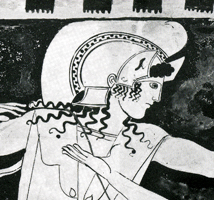
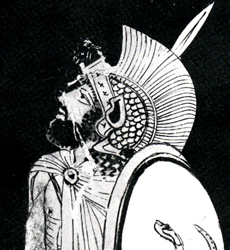
Cuirass
As well as helmet and shield a hoplite wore body armour. In the 8th to 6th centuries BC this was usually made of bronze beaten into shape to fit the torso. Examples are shown right. The bottom curved out and so these are often known as bell cuirasses. Later they became more and more shaped to look like the muscles of the chest and abdomen, and we call these muscle cuirasses (see photo of a re-enactor below).
Bronze cuirasses gave good protection but were a little heavy and cumbersome, weighing about 6kg. By the time of the Persian Wars (early 5th century BC) another type of body armour had become more popular - the linen cuirass.
Linen Cuirass
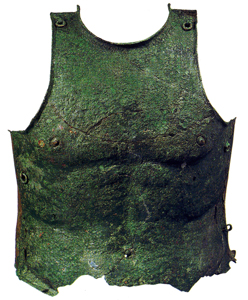

The linen cuirass wrapped round the body and was tied on the left side. Two big flaps were pulled down over the shoulders and tied in front. In the pictures you can see the string tied together at the front.
Sometimes the sides of the cuirass had metal plates, for a hoplite was especially vulnerable in his side.
At the bottom there were some flaps, often made of leather, to protect the groin and upper thighs, but allow movement.
Underneath all that the hoplite would usually wear a tunic - a simple piece of clothing like a short dress.

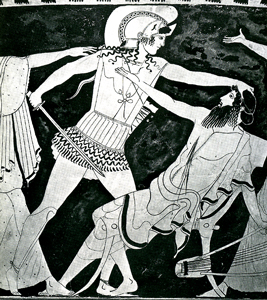
Greaves
The other main items of armour worn by many hoplites were his greaves. These were lower leg protectors, like shin pads, made of bronze. You can see the hoplites in some of the pictures above right wearing them. They were elegantly made and covered the knee down to the foot. Examples of real greaves in museums are shown to the right.
The bronze was shaped all the way round with a small gap at the back. The greave was pulled apart and tightly fitted the leg muscles. Other kinds were more open and had to be strapped on.
There were other kinds of greaves, for the thigh, the upper arm, and the lower arm. However these are rarely shown in art and were rarely used. They would have restricted movement in battle and weighed the hoplite down too much. In fact in the later 5th century BC hoplites stopped wearing even lower leg greaves.
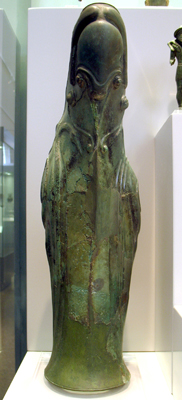

These re-enactors were photographed at the Sheffield Military Fair in August 2009. You can see both the solid bronze cuirass (in this case made with brass) and the linen cuirass (the lower one has bronze scales).
